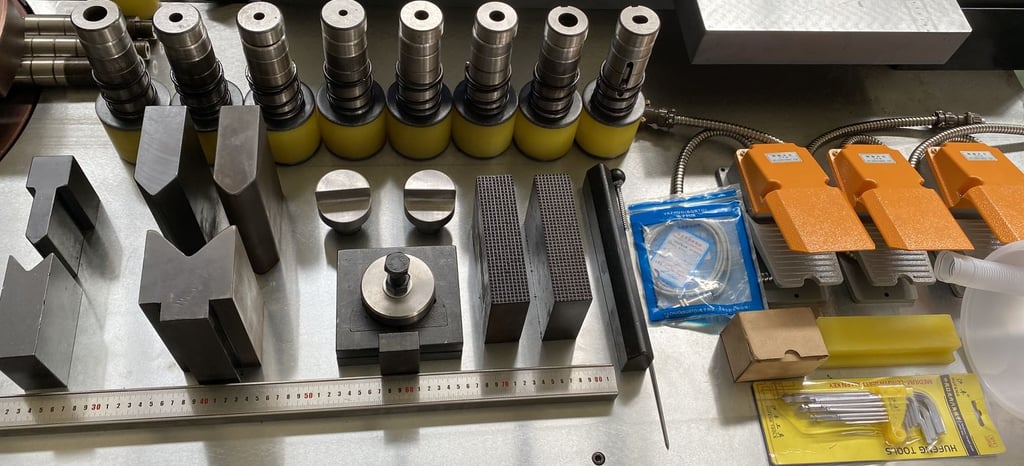Busbar Processing Machine Maintenance Cost Disclosure: Why Indonesia and Egypt Small Factories Prefer Low-Consumption Design?
6/27/20254 min read


Introduction to Busbar Processing Machines
Busbar processing machines are essential tools in the manufacturing industry, particularly in the production of electrical infrastructure components. These machines are designed specifically for the processing of busbars, which are conductive materials used to distribute electrical power. Busbars serve as critical junctions in electrical systems, ensuring effective power transmission while maintaining safety and efficiency.
The basic components of busbar processing machines typically include cutting, bending, punching, and welding systems. Each function is designed to execute specific tasks necessary for shaping and preparing busbars for installation in electrical systems. For instance, cutting machines ensure precise lengths and dimensions, while bending units allow for customizable shapes to meet various installation requirements. The integration of these components streamlines the manufacturing process, boosting productivity and improving overall production quality.
Understanding the working principles behind these machines is crucial for efficiently maintaining them. Busbar processing machines often operate using advanced technologies, such as programmable logic controllers (PLCs), which optimize their performance and enhance their reliability. The operational effectiveness of these machines is influenced by factors such as energy consumption and maintenance costs. In particular, a low-consumption design can significantly reduce operational expenses, making these machines more appealing to small factories, particularly in regions like Indonesia and Egypt.
The relevance of maintenance costs cannot be underestimated, as they directly affect the long-term viability and efficiency of busbar processing machines. Regular maintenance practices, which include routine inspections, part replacements, and performance assessments, play a vital role in prolonging the lifespan of the machinery and ensuring uninterrupted production cycles. As such, manufacturers must consider these aspects when selecting busbar processing machines, especially when evaluating options that provide low energy consumption alongside operational savings.
Understanding Maintenance Costs in Small Factories
Maintenance costs play a crucial role in the operational efficiency of small factories, particularly when it comes to busbar processing machines. These costs can be categorized into three main types: routine maintenance, spare parts acquisition, and unexpected repairs. For small factories in Indonesia and Egypt, managing these expenses is essential, as their limited budgets necessitate a careful approach to maintenance strategies.
Routine maintenance involves periodic checks and adjustments designed to prevent machine breakdowns. The frequency and complexity of these tasks can vary based on the technology utilized. For instance, more advanced busbar processing machines may require specialized tools and technicians, increasing costs. In contrast, opting for low-consumption designs can result in lower frequency and decreased complexity of routine maintenance, which is advantageous for resource-constrained operations.
Spare parts costs also constitute a significant fraction of maintenance budgets. Small factories often face challenges sourcing authentic components at competitive prices, especially in markets prone to supply chain disruptions. When factories invest in reliable, low-consumption designs, they typically experience fewer breakdowns and, consequently, reduced reliance on spare parts. The selection of high-durability materials and components in these designs contributes to lower long-term costs, proving beneficial for budget-conscious businesses.
Unexpected repairs represent another critical factor in maintenance spending. These can arise from unforeseen machine failures, which are often exacerbated in environments with limited technical support. Low-consumption designs are known for their reliability and performance stability, which can minimize the occurrence of unexpected breakdowns. This reliability is particularly paramount for small factories that cannot afford the downtime associated with such repairs.
By thoroughly understanding and analyzing these maintenance cost factors, small factories in Indonesia and Egypt can strategically select busbar processing machines that not only align with their operational needs but also significantly reduce the financial burden associated with machine upkeep. This thoughtful selection process enhances overall productivity while adhering to strict budgetary constraints.
The Benefits of Low-Consumption Machine Designs
Low-consumption busbar processing machines are increasingly favored by small factories in countries like Indonesia and Egypt due to their significant advantages in energy efficiency and cost-effectiveness. These advanced designs typically consume less energy compared to traditional models, leading to notable reductions in operational expenses. As electricity costs continue to rise globally, the need for factories to implement energy-saving solutions has become more critical than ever. The adoption of low-consumption designs not only alleviates financial burdens but also enhances overall productivity by minimizing energy waste.
One of the primary benefits of utilizing a low-consumption busbar processing machine is the extended lifespan of the equipment. Machines that operate on optimized energy settings tend to experience less wear and tear, thereby resulting in fewer breakdowns and maintenance requirements. This longevity translates into lower maintenance costs for factory owners. Additionally, with less frequent replacements needed, the long-term investment in low-consumption models proves more favorable financially. This aspect is particularly appealing to small factory owners with limited budgets who are keen on ensuring maximum return on investment.
Furthermore, the environmental implications of low-consumption designs cannot be overstated. As factories become more conscious of their carbon footprints, adopting energy-efficient machinery plays a critical role in enhancing sustainability efforts. Testimonials from small factory owners in Indonesia and Egypt who have transitioned to low-consumption busbar processing machines highlight significant reductions in energy-related costs alongside improved production efficiency. For instance, a small factory in Indonesia reported a 30% decrease in electricity usage after switching to a low-consumption design, coupled with improved output quality. Such success stories reinforce the positive impact of adopting these energy-efficient solutions, solidifying their status as a preferred choice for small manufacturers.
Comparative Analysis: Indonesia vs. Egypt in Factory Preferences
In recent years, the preferences of small factories in Indonesia and Egypt regarding busbar processing machines have reflected significant economic, cultural, and logistical trends. Both nations exhibit unique characteristics that influence their choices toward low-consumption designs, thus necessitating a comparative analysis to comprehend this phenomenon thoroughly.
Economically, Indonesia has experienced substantial growth, particularly in its manufacturing sector. The government has pursued policies aimed at boosting local production. This includes incentives for adopting energy-efficient technologies, which have led small factories to favor busbar processing machines with low energy consumption. In contrast, Egypt's economy has faced challenges, including fluctuating currency values and inflation. Consequently, small factory operators are often under pressure to minimize operational costs, further propelling the preference for machines that promise lower power needs and maintenance expenditures.
Culturally, the decision-making process in Indonesian factories often involves collective discussions where sustainability and environmental impacts are increasingly prioritized. This has led to a favorable disposition toward low-consumption designs as they align with broader community values regarding resource conservation. Conversely, in Egypt, cultural dynamics interplay with historical reliance on conventional manufacturing practices, making the transition to modern technologies like low-energy consumption designs more gradual.
From a logistical perspective, Indonesia's vast archipelago presents unique challenges in terms of supply chains, necessitating machines that consume less power, given energy costs can be significant in remote areas. Likewise, Egyptian small factories often face resource limitations, making efficiency in energy consumption a crucial consideration when selecting busbar processing machinery. This comparative analysis reveals that while both countries are leaning towards low-consumption designs, the driving factors are shaped by distinct economic climates, cultural practices, and logistical considerations, ultimately influencing factory operators' decisions in each region.
Innovate
Leading manufacturer of busbar processing equipment solutions.
Contact
Support
+131 2713 4627
© 2025. All rights reserved.
